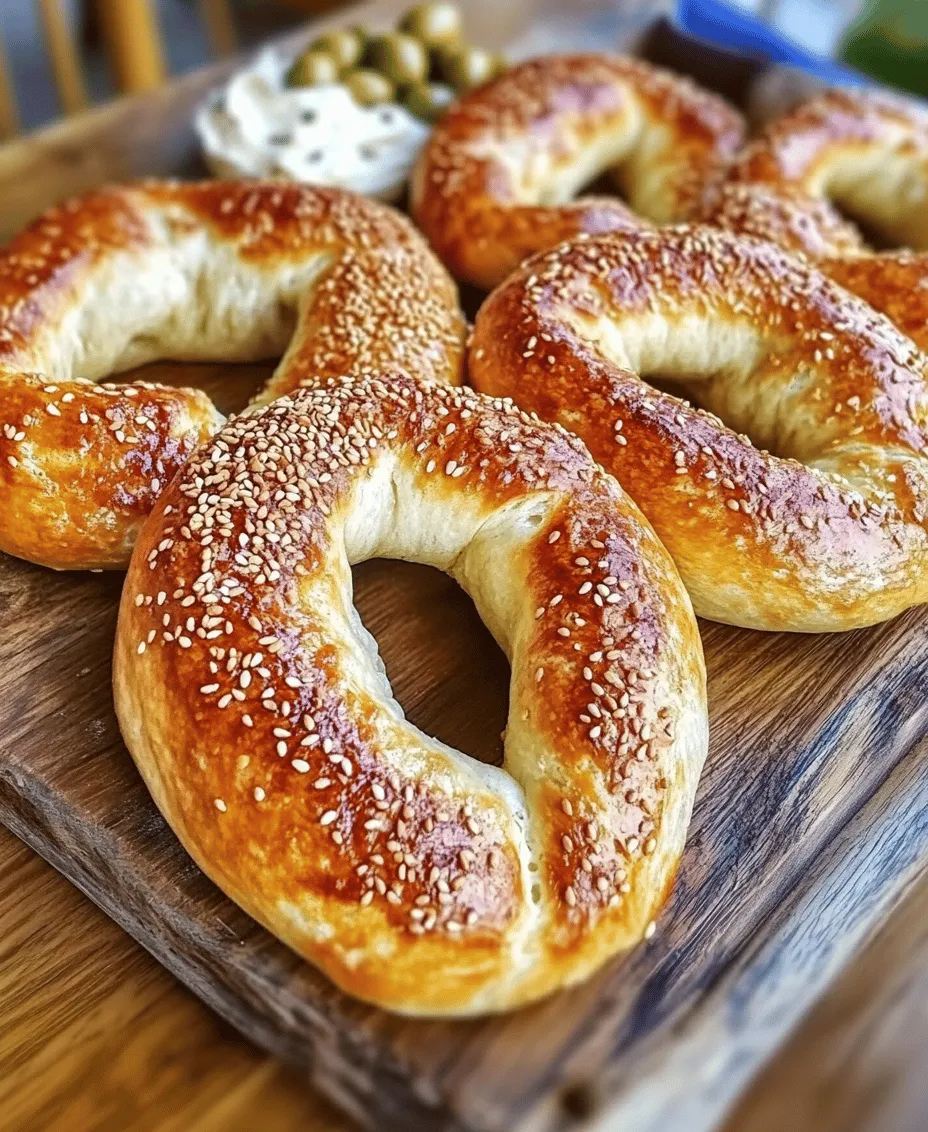Introduction
Simit, a beloved staple of Turkish street food, captivates both locals and tourists alike with its unique texture and delightful flavor. This traditional Turkish sesame bagel is not just a snack; it is a culinary treasure deeply woven into the fabric of Turkish culture and cuisine. From bustling markets to charming cafes, simit is enjoyed at any time of day—be it for breakfast paired with cheese and olives, as a midday snack, or even as a light evening meal. The warm, golden-brown rings, coated generously with sesame seeds, are a sight to behold and an experience to savor.
What makes simit special is not only its distinct flavor profile but also the artisanal methods used to create it. The dough is lovingly prepared, shaped into rings, and then dipped in a mixture that gives it a beautiful sheen and a crunchy outer layer. This recipe will guide you through the process of making simit at home, allowing you to replicate the authentic taste of Turkey right in your kitchen.
Understanding Simit
Historical Background of Simit
The history of simit dates back to the Ottoman Empire, where it was commonly sold by street vendors throughout Istanbul. Originally known as “gevrek,” the name evolved over time, and so did the recipe. While simit has undergone various transformations, it has retained its essential characteristics—its chewy texture, crusty exterior, and nutty flavor from the sesame seeds. This unique bagel-like bread is believed to have been introduced by the Byzantine Greeks, but it gained prominence and a distinct identity in Turkish cuisine. Today, simit is a symbol of Turkish hospitality, often served to guests alongside tea or as part of a larger spread.
Variations of Simit Across Different Regions in Turkey
While simit was initially popularized in Istanbul, its variations can be found across different regions of Turkey. For instance, in the coastal cities, simit may include a hint of local spices or herbs that reflect the regional palate. In contrast, southeastern regions may offer toppings or fillings that showcase local ingredients. This adaptability not only highlights the versatility of simit but also emphasizes its role as a canvas for regional flavors and culinary creativity. Despite these variations, the essence of simit remains unchanged—a delicious, sesame-coated bagel that brings people together.
Cultural Significance and Occasions for Serving Simit
Simit holds a special place in Turkish culture, often associated with leisurely breakfasts and social gatherings. It is a common sight in Turkish tea gardens, where friends and family gather to enjoy each other’s company over cups of tea and plates of simit. During special occasions and festivities, simit is often prepared in larger quantities and served alongside other traditional dishes. Its portability makes it a popular choice for picnics and outdoor gatherings, where it can be easily shared. As a street food, simit is not just a meal; it embodies the spirit of Turkish communal dining, where food acts as a medium for connection and celebration.
Ingredients Breakdown
Creating the perfect simit requires a careful selection of ingredients, each playing a vital role in the final product. Here’s a breakdown of the essential components needed for this delightful recipe:
– All-Purpose Flour: The foundation of the simit, all-purpose flour provides the necessary structure and texture. Its moderate protein content ensures a chewy yet tender bite, allowing the dough to rise beautifully.
– Active Dry Yeast: This ingredient is crucial for fermentation, as it creates the airy structure characteristic of simit. The yeast ferments the sugars in the dough, producing carbon dioxide that causes it to rise.
– Warm Water: Important for activating the yeast, warm water helps create the right dough consistency. It should be warm to the touch but not too hot, as excessive heat can kill the yeast.
– Granulated Sugar: Sugar not only enhances the flavor of the simit but also aids in the activation of the yeast. It provides a subtle sweetness that complements the savory elements.
– Salt: A vital ingredient for balancing flavors, salt enhances the overall taste of the simit and strengthens the dough structure by tightening the gluten.
– Olive Oil: Adding moisture and richness, olive oil contributes to a tender crumb and helps achieve that desirable golden crust.
– Molasses: This ingredient adds depth of flavor and a darker color to the simit. It provides a slight sweetness that contrasts beautifully with the nutty sesame seeds.
– Sesame Seeds: The crowning glory of simit, sesame seeds are what give this bagel its signature flavor and texture. They toast beautifully, adding a nutty crunch and a rich aroma.
– Optional Nigella Seeds: For those looking to enhance the flavor further, nigella seeds (also known as black cumin) can be added. They provide a unique, slightly peppery taste that complements the sesame seeds perfectly.
Step-by-Step Guide to Making Simit
Activating the Yeast
The first step in making simit is activating the yeast. This process is critical, as it sets the stage for the dough to rise. Start by warming your water until it is comfortably warm to the touch—ideally between 100°F to 110°F (37°C to 43°C). Too hot, and you risk killing the yeast; too cold, and it won’t activate properly.
Once you’ve achieved the right temperature, pour the warm water into a mixing bowl. Add the granulated sugar and sprinkle the active dry yeast on top. Stir gently to dissolve the yeast and sugar, then let it sit for about 5 to 10 minutes. You’ll know the yeast is activated when it becomes frothy and bubbly, indicating that it’s alive and ready to work its magic in your dough.
Mixing the Dough
Once your yeast mixture is frothy, it’s time to combine the ingredients. In a large mixing bowl, measure out your all-purpose flour and create a well in the center. This technique allows you to gradually incorporate the wet ingredients without making a mess. Pour the activated yeast mixture into the well, followed by the olive oil, salt, and molasses.
Using a wooden spoon or your hands, begin mixing the flour into the wet ingredients, starting from the inner rim of the well and working your way outward. Continue until the mixture forms a shaggy dough. At this point, it’s useful to keep a bench scraper handy for any sticky bits that may cling to the bowl.
Kneading the Dough
Kneading is a crucial step for developing the gluten structure in your simit dough. Transfer the shaggy dough onto a lightly floured surface and begin to knead it. Use the heel of your hand to push the dough away from you, then fold it back over itself. Rotate the dough a quarter turn and repeat this process for about 8 to 10 minutes.
As you knead, you’ll notice the dough becoming smoother and more elastic. It should be slightly tacky but not overly sticky. A good visual cue is when the dough springs back slightly when you gently poke it with your finger. This elasticity is key to achieving that perfect chewy texture in your finished simit.
First Rise Process
Once you’ve kneaded the dough to the right consistency, it’s time for the first rise. Lightly oil a clean bowl and place the dough inside, turning it to coat the surface with oil. Cover the bowl with a damp cloth or plastic wrap to prevent moisture loss. Let the dough rise in a warm, draft-free area until it doubles in size, which usually takes about 1 to 1.5 hours.
During this time, the yeast will ferment and create gas bubbles, causing the dough to rise. The ideal environment for rising is around 75°F to 80°F (24°C to 27°C). If your kitchen is cooler, consider placing the bowl in an oven that’s turned off but has the light on, as this provides a warm spot for the dough to thrive.
This initial rise is essential for developing flavor and texture, so be patient and let the dough do its work. Once it has doubled in size, you’ll be ready to move on to shaping your simit and preparing them for their second rise.
With these steps, you are well on your way to creating the beloved Turkish simit. Stay tuned for the next part where we will delve into shaping, boiling, and baking this delightful treat, ensuring that you can enjoy the authentic taste of Turkey right at home.

Ideal Conditions for Dough Rising
Creating the perfect Simit requires a careful approach to dough rising. Ideal conditions for rising include a warm, draft-free environment. The optimal temperature for yeast fermentation is typically between 75°F and 80°F (24°C to 27°C). If your kitchen is cooler, you can create a warm spot by placing the dough in an unheated oven with the light on. Alternatively, placing the dough near a radiator or in a warm corner of the kitchen can also be effective.
Explanation of What Happens During This Fermentation Phase
During the fermentation phase, the yeast in the dough begins to feed on the sugars present, producing carbon dioxide and alcohol. This process not only causes the dough to rise but also develops flavor and texture. The dough becomes airy and elastic, allowing it to hold its shape during baking. Additionally, the gluten structure strengthens, which is crucial for achieving that classic chewy bite that Simit is known for.
Shaping the Simit
Once your dough has risen, it’s time to shape your Simit. Start by gently deflating the dough on a lightly floured surface to release any trapped air. Divide the dough into equal portions, typically around 10 to 12 pieces, depending on your desired size.
Techniques for Rolling and Twisting the Dough
To shape each piece into a bagel, roll it into a long rope, about 12 to 14 inches (30 to 35 cm) in length. Then, twist the ends together to form a circle, ensuring they are well sealed to prevent them from unraveling during boiling and baking. The twisting technique not only creates a visually appealing shape but also enhances the texture of the bagel.
Tips for Achieving Uniform Sizes
For uniformity, you may want to use a kitchen scale to weigh each piece of dough before shaping. This ensures that all your Simits are of equal size, which is crucial for even cooking and presentation. If you prefer a more rustic look, a little variation can add charm and character to your final product.
Preparing the Bath
Before baking, you need to prepare the bath that gives Simit its distinctive crust.
The Role of Molasses in Flavor and Texture
The bath typically consists of water mixed with molasses. Molasses not only adds a deep, rich flavor to the bagels but also contributes to the signature dark color and chewy texture of the crust. The sugars in the molasses caramelize during baking, creating that desirable golden-brown finish.
Importance of the Dipping Process in Creating the Signature Crust
Dipping the shaped Simit in this bath is a critical step. It helps to seal the outer layer of the dough, creating a barrier that allows for a chewy crust while keeping the inside soft and fluffy. This process also enhances the flavor, making your Simit irresistibly delicious.
Coating with Sesame Seeds
After dipping, it’s time to coat your Simit with sesame seeds.
Techniques for Even Coating
To achieve an even coating, place sesame seeds on a flat plate and gently roll each bagel in the seeds, ensuring all sides are well-covered. You can also press the bagel lightly into the seeds to ensure they adhere properly. For a twist on the traditional flavor, consider mixing in some nigella seeds, which add a unique peppery taste that complements the nutty sesame.
Optional Variations with Nigella Seeds
Nigella seeds, also known as kalonji or black cumin, can be sprinkled alongside sesame seeds for an extra layer of flavor. When combined, they not only enhance the taste but also add visual appeal to your Simit, showcasing a beautiful contrast against the golden crust.
Second Rise
Following the coating, allow the Simit to rise again for about 15 to 20 minutes.
Importance of This Step for Achieving the Perfect Texture
This second rise is crucial for achieving the perfect texture. It allows the dough to relax after shaping and ensures that the bagels will be fluffy and light after baking. Skipping this step can result in denser Simit, so be patient and let them puff up slightly.
Time Considerations and Signs of Readiness
Keep an eye on the dough during this second rise. You’ll know they are ready when they appear slightly puffy and have increased in size. This is a sign that the yeast is still active and ready to work its magic in the oven.
Baking the Simit
Preheat your oven to 425°F (220°C) to ensure an even bake.
Preheating Tips for an Even Bake
To achieve the best results, ensure your oven is fully preheated before placing your Simit inside. Use an oven thermometer to verify the temperature, as many ovens can be off by a few degrees. A hot oven is key to developing the crust quickly, allowing the bagels to rise properly without drying out.
Ideal Baking Times and Temperatures for Achieving a Golden Crust
Bake your Simit for about 15 to 20 minutes, or until they are golden brown. Keep an eye on them during the last few minutes of baking; every oven varies, and you want to catch them just as they reach that perfect golden hue.
Cooling and Serving Suggestions
Once baked, it’s essential to let your Simit cool properly.
Importance of Cooling on a Wire Rack
Transfer the Simit to a wire rack to cool. This allows air to circulate around them, preventing the bottoms from becoming soggy. Cooling on a rack also helps maintain their chewy texture and prevents them from becoming too soft.
Recommendations for Serving: Pairings and Presentation Ideas
Simit is best enjoyed fresh, but they can also be stored for a few days. Serve them warm with a variety of accompaniments. Traditional Turkish pairings include feta cheese, olives, and tomatoes, but feel free to get creative. Slather on some cream cheese, or enjoy them with a drizzle of honey for a sweet twist. For a modern take, use Simit as a base for breakfast sandwiches or as a side for soups and salads.
Nutritional Information
Each Simit is not just delicious but also nutritious.
Overview of the Nutritional Value per Serving
Typically, a single Simit contains around 200 calories, with 7 grams of protein, 30 grams of carbohydrates, and 6 grams of fat, thanks to the sesame seeds. They are a good source of fiber and provide essential vitamins and minerals, particularly if you use whole wheat flour.
Discussion on Health Benefits of Ingredients Used
The sesame seeds are rich in healthy fats, protein, and essential nutrients like calcium and magnesium. They also contain antioxidants, which contribute to overall health. The use of molasses adds a touch of natural sweetness while providing iron and other minerals that are beneficial for your body.
Cultural Pairings and Serving Ideas
Simit is a beloved snack in Turkey, often enjoyed at breakfast or as a mid-afternoon treat.
Traditional Turkish Accompaniments for Simit
In Turkey, Simit is commonly paired with tea or coffee. It’s also typical to see it served with a variety of spreads, including hummus, tahini, or yogurt. Fresh vegetables, such as cucumbers and radishes, add a refreshing crunch that complements the chewy bagel.
Creative Ways to Enjoy Simit Beyond Traditional Methods
Beyond the traditional methods, consider using Simit as a base for mini sandwiches. Fill them with smoked salmon, cream cheese, and capers, or try turkey and avocado for a modern twist. They can also be crumbled into salads for added texture or served alongside dips for a unique appetizer.
Ideas for Incorporating Simit into Modern Meals
Incorporate Simit into brunch by serving them alongside eggs and fresh fruit. Alternatively, create a Simit sandwich with roasted vegetables and pesto for a delicious lunch option. Their versatility allows you to enjoy them in many different ways, making them a delightful addition to any meal.
Conclusion
Making Simit at home is a rewarding experience that connects you with the rich culinary traditions of Turkey. The process of kneading, rising, and baking these sesame bagels brings joy to the kitchen, and the delicious aroma that fills your home is simply irresistible.
Whether you enjoy them fresh from the oven or incorporate them into a modern meal, homemade Simit offers a delightful taste of Turkish culture. So gather your ingredients, follow this recipe, and embark on a flavorful journey. Sharing these delicious creations with friends and family will surely bring smiles and satisfaction, fostering a love for homemade bread and the joy of cooking together.


